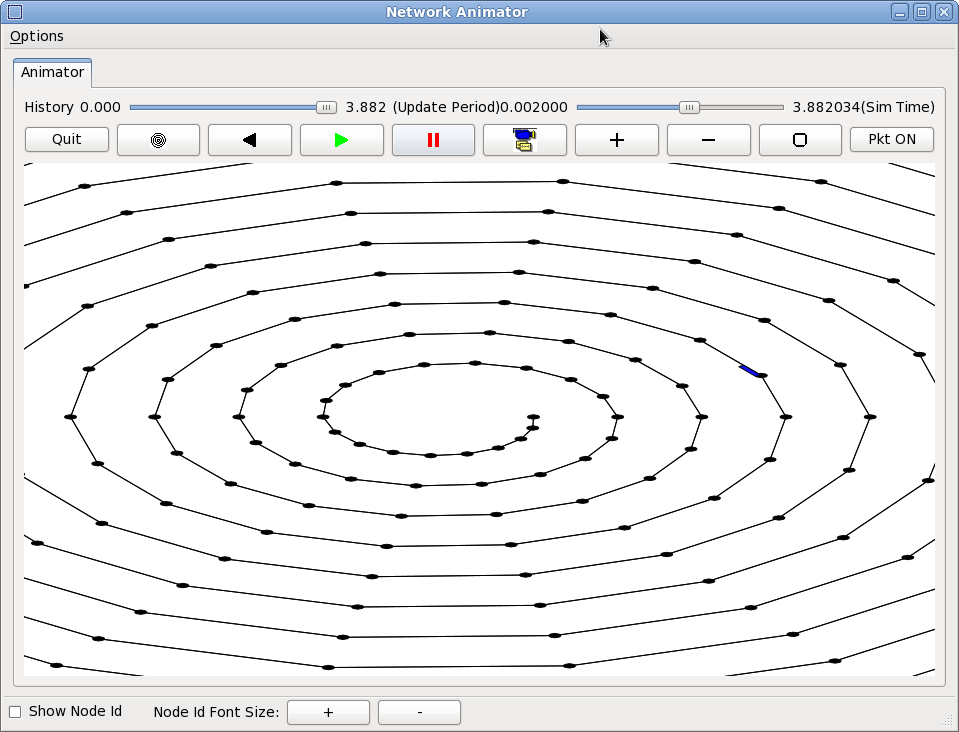CCNx examples¶
Under example/ccnx there is more realistics examples using the implementation of an experimental protocol named CCN. In this examples we use the PARC implementation named CCNx (c) in its early version 0.6.2. Bake has already installed for you Ccnx.
Example CCNX-SIMPLE¶
This simulation launches a ccnd daemon, publishes a file using ccnput and retrieves this data using ccnget command, all commands are on a single node:
$ source bakeSetEnv.sh
$ dce-ccnd-simple
Verify the status of execution:
$ cat files-0/var/log/*/status
Start Time: NS3 Time: 0s ( +0.0ns) , REAL Time: 1328707904
Time: NS3 Time: 0s ( +0.0ns) , REAL Time: 1328707904 --> Starting: /tmp/ccn/build/bin/ccnd
Time: NS3 Time: 59s ( +59001000000.0ns) , REAL Time: 1328707905 --> Exit (0)
Start Time: NS3 Time: 1s ( +1000000000.0ns) , REAL Time: 1328707904
Time: NS3 Time: 1s ( +1000000000.0ns) , REAL Time: 1328707904 --> Starting: /tmp/ccn/build/bin/ccnput
Time: NS3 Time: 2s ( +2001000000.0ns) , REAL Time: 1328707905 --> Exit (0)
Start Time: NS3 Time: 2s ( +2000000000.0ns) , REAL Time: 1328707905
Time: NS3 Time: 2s ( +2000000000.0ns) , REAL Time: 1328707905 --> Starting: /tmp/ccn/build/bin/ccnget
Time: NS3 Time: 2s ( +2002000000.0ns) , REAL Time: 1328707905 --> Exit (0)
Start Time: NS3 Time: 59s ( +59000000000.0ns) , REAL Time: 1328707905
Time: NS3 Time: 59s ( +59000000000.0ns) , REAL Time: 1328707905 --> Starting: /tmp/ccn/build/bin/ccndsmoketest
Time: NS3 Time: 59s ( +59001000000.0ns) , REAL Time: 1328707905 --> Exit (0)
Verify the output of the command ccnget:
$ cat files-0/var/log/53514/stdout
The wanted data is here :)
Example CCND LINEAR MULTIPLE¶
This simulation uses multiple nodes placed in a line, each node are linked 2 by 2 by a point to point link, each node holds a ccnd daemon, the first node put a file (with ccnput), and the last node fetch this file (with ccnget). Also each node minus the first one forward interrests starting with /NODE0 to its predecessor.
The launch script dce-ccnd-linear-multiple offer 3 options:
$ dce-ccnd-linear-multiple --PrintHelp
--PrintHelp: Print this help message.
--PrintGroups: Print the list of groups.
--PrintTypeIds: Print all TypeIds.
--PrintGroup=[group]: Print all TypeIds of group.
--PrintAttributes=[typeid]: Print all attributes of typeid.
--PrintGlobals: Print the list of globals.
User Arguments:
--nNodes: Number of nodes to place in the line
--tcp: Use TCP to link ccnd daemons.
--kernel: Use kernel linux IP stack.
1. nNodes allows to choose the Number of Nodes,
2. tcp allows to use TCP or if not UDP to connect the ccnd deamons (via forwarding interrest).
3. kernel allows to use Linux IP Stack (only working in advanced mode) instead of |ns3| one.
for example with 200 nodes and TCP transport you should see this in the first ccnget output command:
$ dce-ccnd-linear-multiple --nNodes=200 --tcp=1 --kernel=0
$ cat files-199/var/log/30916/status
Start Time: NS3 Time: 2s ( +2700000000.0ns) , REAL Time: 1328710217
Time: NS3 Time: 2s ( +2700000000.0ns) , REAL Time: 1328710217 --> Starting: build/bin/ccnget
Time: NS3 Time: 4s ( +4399711801.0ns) , REAL Time: 1328710218 --> Exit (0)
$ cat files-199/var/log/30916/stdout
The wanted data is here :)[
You can see that the first get take about 1.6 seconds. This example produce also a netanim file named NetAnimLinear.xml that you can use with the NetAnim tool in order to visualize packets moving through the Network:
Example VLC Player¶
This demonstration show how to watch video using VLC CCN and NS3.
Prerequisite¶
You should be able to build and run the CCN plugin for VLC in order to display Video using CCNx. So you should follow carefully the instructions delivered in CCNx distribution in the directory : ccnx-0.6.1/apps/vlc
You should ensure that the executable named ns3-dev-tap-creator-debug is owned by root and have the sticky bit setted :
$ cd build/bin
$ su
# chown root ns3-dev-tap-creator-debug
# chmod +s ns3-dev-tap-creator-debug
Overview¶
In this example we use other exe than ccnd:
- vlc the well known media player
- ccnr is a CCN repository used to serve the Video file
- SyncTest used to fill the repository with our Video file
The first exe is not usable under DCE: vlc use a graphical interface and DCE do not supports this kind of application.
So vlc will be launched normally outside of DCE environment. We will also use 2 ccnd:
- the first ccnd will be launched normally outside DCE, it will be the server for vlc player ,it will use the standard CCNx port ie 9596.
- the second ccnd will be launched inside DCE listening on second node.
then we install ccn route like this : first ccnd forward every interests starting by /VIDEO/ to second ccnd.
In order to link real world and NS3 network we use the ns-3 TAP BRIDGE functionnality which is more documented there: Tap NetDevice
A schema of our network:
+----------+
| external |
| Linux |
| Host | 1 ccnd on standard port (9596)
| |
| "thetap" | 1 vlc client querying ccnx:///VIDEO/bunny.ts
+----------+
| 10.0.0.1 |
+----------+
| node0 node1
| +----------+ +----------+
+-------| tap | | |
| bridge | | |
+----------+ +----------+
| CSMA | | CSMA |
+----------+ +----------+
| 10.0.0.1 | | 10.0.0.2 | ccnd and ccnr
+----------+ +----------+
| |
| |
| |
=================
CSMA LAN 10.0.0
Before running the launch script you should edit it to furnish a Video file in the corresponding variable :
$ vi run-tap-vlc.sh
....
VIDEOFILE=big_buck_bunny_240p_mpeg4.ts
....
Note also that NS3 is launched in real time mode in order to communicate to real world.
Run :
$ cd $BASEDCE/myscripts/ccn-tap-vlc
$ ./run-ccn-vlc.sh
If all is right you should see a vlc window playing the video, then after 600 seconds the script stops itself if you interrupt the script before you should terminate real the processes ie:
- 1 instances of ccnd
- and 1 dce-ccn-vlc
Note that if you replay the video (url: ccnx:///VIDEO/bunny.ts) the content should be cached in first ccnd so in this case NS3/DCE will probably not be used for the second delivery of the video.

